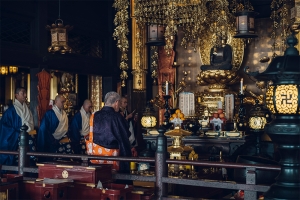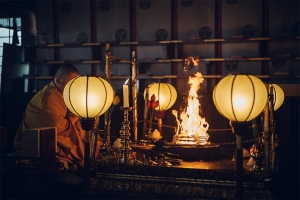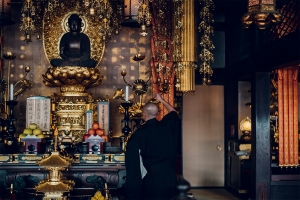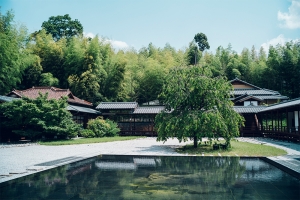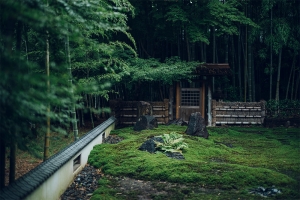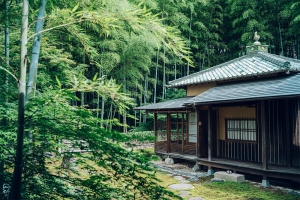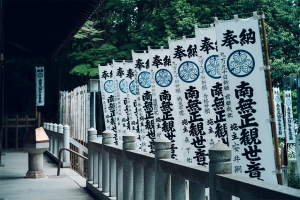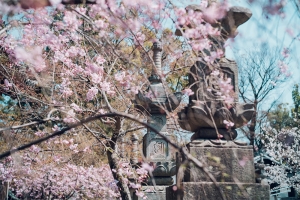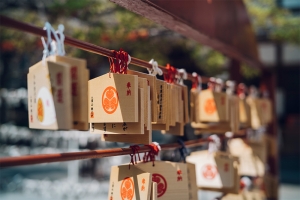
Stroll like a lord or lady
in a place loved by lords and ladies
Yagoto-san Kousho-ji Temple
The extensive grounds of Yagoto-san Kousho-ji Temple stretch across slopes in eastern Nagoya. In 1686, famed monk Tenzui opened a temple among the trees in the peaceful setting of these rolling hills. This temple was then strongly connected with the historically important lords of the Owari branch of the ruling Tokugawa family. Well visited by pilgrims, it is also a site on the Chita-Shikoku 88 Merit-making, the Tokai 36 Fudo, the Owari 33 Kannon, the Nagoya 21 Daishi, and Nagoya 7 Lucky Gods prayer circuits.
The precincts cover two hills, Nishiyama to the west and Higashiyama to the east. Nishiyama formerly included the land where the Main Hall and Five-storey Pagoda are now located. In Higashiyama, you can see numerous structures, including magnificent halls and towers, built since the 17th century among the flourishing trees.
Within the grounds you can marvel at the only wooden pagoda in the whole Tokai region. Built in 1808, this elegant Five-storey Pagoda is a National Important Cultural Asset. Everywhere, in the ancient documents held in the halls, and in the Buddhist images and implements, you can see the centuries-old roots of history.
For each generation throughout 330 years, the gates of Yagoto-san Kousho-ji Temple have been open to all who want to enter. Still today, young monks come here for training and, more than ever, the local people often come just to enjoy a stroll. On land that has been long revered, among ancient structures and monuments, surrounded by nature, you can find peace and leave your cares behind.



Yagoto is known as Nagoya’s foremost area of natural beauty. Travel only 20 minutes from Nagoya City center and, after only few steps into the grounds, the noise of the city becomes but a distant memory.
After passing the approach, beyond the Inner Gate, the 26-meter-high Five-storey Pagoda rises into view. The elegant flowing lines of the curved eaves and roofs have stood with a timeless stately presence for more 200 years.
North of the Five-storey Pagoda, the Main Hall was built in 1750, principally to enshrine the Amida Nyorai. Adjacent to the Main Hall you can enter the Fumon Garden, which has water features. Here you can see historically and culturally important buildings which are connected with covered walks. The entrance fee varies depending on the season.(From 500yen) Meanwhile, put at ease by the sound of trickling water, you will feel at one with nature as you experience the serenity of birdsong, the caressing breeze, and the whoosh of rustling leaves.
The centerpiece of Fumon Garden is Hourai-tei and its large rectangular pond. Even so, in spring, the sight of the weeping cherry reflected from the white sand is unforgettable.
Other covered walks will take you to the Taisho-Period Chikusui-tei and Sokoan, which has a teahouse, and Ko’un-tei. O’shoin, with its vast open floor space, is popular for all kinds of meetings.
The bamboo groves that reach down to Chikusui-tei and Sokoan brings a fresh green tinge. In this Japanese garden with its ponds and lanterns and tinkling cascades, you may feel time dissolved by the perpetual flow of purifying water.
If you stroll the covered walks you will encounter an impressive Japanese garden, historic wooden buildings, and the refined culture of tea.
Time of year
The Year at Kousho-ji Temple
Many people come to Kousho-ji Temple for seasonal events as well as Buddhist events.All through the year,interesting occasions attract many visitors.You are welcome to drop by on any of these calender events.
-

5th and 13th of every month
Ennichi
Many people come to Kousho-ji Temple for seasonal events as well as Buddhist events.All through the year,interesting occasions attract many visitors.You are welcome to drop by on any of these calender events.
-

Ja.1-3
New Year Prayers
New year prayer are typically made for health,household or traffic safety,school or job entry,and business prosperity.
-

Jan.5,May 5,and Sep.5
Kitohe
January,May,and September are the months when we most express our grafitude for the power of the Buddha.To get closer to the Buddha,the 600-scroll Great Wisdom Sutra is recited.
-

Feb.3
Setsubun Prayers
At the New year of the old calendar.brans are cast to ward off evil and invite good fortune. At the same time,in the Star Festial, prayers are offered to supplicate for good to year to come.
-

October
Thousand-lantern memorial Event
The highlight of the temple year.
Incense,flowers,and light are offered to comfort the spirits of all deceased living things. You can see a procession of children and experience a magical mood in the light of lanterns arranged on either side of the approach. -

Dec.31
Tolling out the passing year
To release people from sin,the temple bell is struck 108 times.
Tour
【Tour】“Feel the blessings of Japanese culture & Buddhist temple”
About scheduled tours with English-speaking guides

Yagoto-san Kousho-ji Temple will start regular tours with an English interpreter.
Among the tours, there is a wellness tour of about 3 hours where participants can experience tea ceremony and Asokukan (meditation) to adjust your mind and body.
[Tour]
Meeting → Tour of the precincts with a priest → Tea ceremony experience → Asokukan meditation → Braking up
| Apply for participation | Aug 6,2024 (Here is the link to the webpage.) |
|---|---|
| Sep 9,2024 (Here is the link to the webpage.) |



| Apply for participation | Here is the link to the webpage. |
|---|
Experience traditional Japanese culture
Tea ceremony experience
Reach beyond time and enjoy the essence of Japanese culture.

The preparation and drinking of tea is central to the culture of Japan. At Chikusui-tei, Matcha tea and confectionary are even more delicious in a fine example of traditional architecture that was built in the Taisho Period(1911-1925).It possesses alcoves to display hanging scrolls and flower arrangements. Why not savor the taste and rich aroma of tea while looking out over a Japanese garden?



The way of tea
Experience tea ceremony in a Japanese-style room. The important thing is to make tea with all your heart. Then it will be delicious. Tea ceremony is related to various Japanese arts and philosophical principles.
| Standard group/time |
60 minutes~ (depends on the size of your group.) |
|---|---|
| Price | The fee is 3,000 yen (tax included) per person. (5 or more people) |
| Reservation | Reservation is required at least 1 month before. |


Asokukan experience
Breathe as one with the breath of the trees and refresh your spirit.

You can’t help but feel calm in the midst of the natural surroundings of Yagoto-san.It’s a great place to experience an age-old way of meditation.
Throughout the history, the principal object of veneration at Yagoto-san Koushoji,the Dainichi Nyorai,has had the power to shine the light of compassion into the heart of anyone.
Why not see if you can feel the light as you sit in the meditation room facing the courtyard? Try the zazen posture and let the sounds of water and the voices of birds ease your spirit.At Yagoto-san,you might even get in touch with yourself.
| Standard group/time |
60 minutes |
|---|---|
| Price | The fee is 1,000 yen (tax included) per person. (5 or more people) |
| Reservation | Reservation is required at least 1 month before. |
Sutra experience

Sutra(Shakyo) is a Buddhist training of copying Buddhist scriptures to another paper. This is one of the religious training
| Standard group/time |
60 minutes |
|---|---|
| Price | The fee is 1,000 yen (tax included) per person. (5 or more people) |
| Reservation | Reservation is required at least 1 month before. |
Temple map

Inner Gatewed
Yagoto-san was formerly divided.Religious training was carried out in Higashiyama to the east,and women were not allowed to enter.This gate used to be the way through the fence and earthwork that separated Higashiyama and Nishiyama.It was reconstructed in front of the Five-storey Pagoda.

Five-storey Pagoda
Koushoji’s landmark building.Built in 1808,rising 26 meters,this National Important Cultual Asset is the only wooden pagoda in the whole Tokai region.Viewed from close up,you can see the beautiful flowing lines of the eaves and roofs.

Main Hall
Enshrining the Amida Nyorai,the Main Hall was built in 1750.At Ennichi,dedication day on the 5th and 13th of every month,more than 5,000 visitors throng the temple grounds.

Main Office
This is the main office of the Koushoji. We assist with the registration of memorial and blessing services. We carry Amulets (Omamori), Charms (Ofuda), the Koushoji seal stamps (Goshuin), Homa sticks (Gomaki), Pilgrimage notebooks (Ohenro no Noukyo), and more.

Kannon Hall
Originally built by Koushoji founder Master Tenzui,this hall was reconstructed by the tenth master,Tando.Its principal object of veneration,the Shokanzeon image(not open to public view),was donated by Mitsutomo,second Tokugawa Lord of Owari.

Fushoden
A wooden tablet is hung over the top of the entrance.It was made according to the calligraphy ’Yagoto-san’ written by Muneharu the seventh Tokugawa Lord of Owari.
This is also where the mortuary tablets of the Tokugawa family are venerated.Other funeral and memorial services are also held here.

Rokujizoson
The six Jizo associated with protecting children.On the left,there are seven stone statues of the Kannon bodhisattva.

Dainichi Hall
This building,located on the highest point of Yagoto-san,holds an image of the Dainichi Nyorai.Standing 3.6meters and weighing 20tons,the fine bronze statue was placed here in 1679 to comfort the soul of the mother of Mitsutomo,second Tokugawa Lord of Owari.

Fumon Garden (Chikusui-tei)
The preparation and drinking of tea is central to the culture of Japan.

Information
Yagoto-san Kousho-ji Temple
78, Yagotohommachi, Showa-Ku, Nagoya City, Aichi, 466-0825, Japan
Tel:052-832-2801(JAPANESE ONLY)
| Hours | am8:00 to pm5:00(Temple Public Area are Free) |
|---|---|
| Access | By Subway Get off at Yagoto sta. on the Tsurumai and Meijo lines. From Exit 1 walk west for about 3min. By road On Route153,temple is at 300m along the Irinaka side of the Yagoto Crossroads. |
| Fumon Garden | Admission fee 500yen(The entrance fee varies depending on the season) *Open am10:00~pm4:00/Irregular holidays *Reservation only.Please make a reservation from the site. (JAPANESE ONLY) |


Translation related to tourism
Aichi Multilingual Call Center
Aichi Goodwill Guides Network (Private guide)
*reservations are required at least 14 days in advance.








